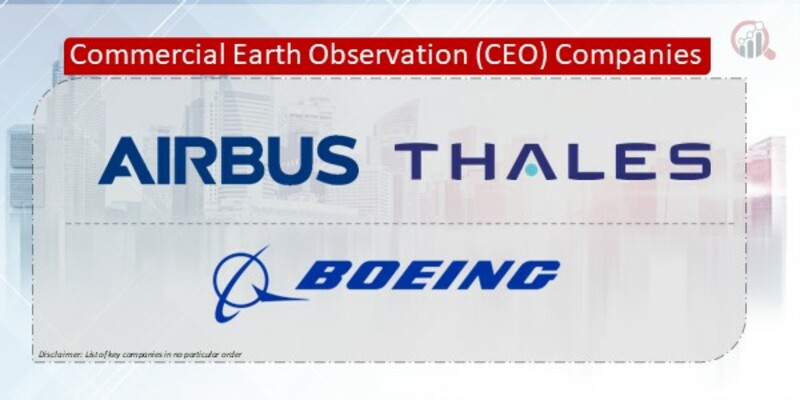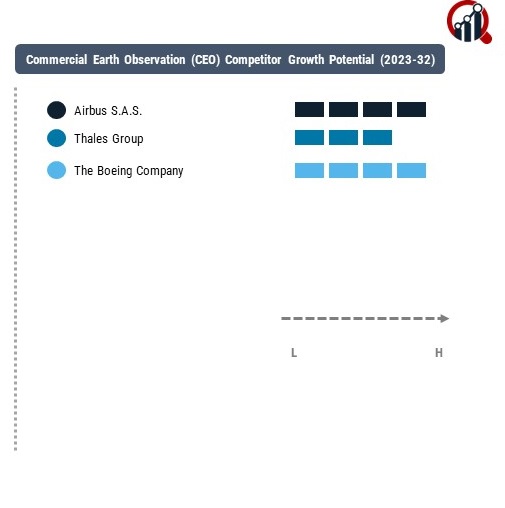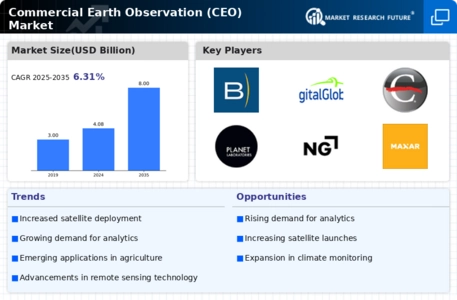Top Industry Leaders in the Commercial Earth Observation CEO Market

Commercial Earth Observation (CEO) Market
The Commercial Earth Observation (CEO) market has witnessed remarkable growth in recent years, driven by the increasing demand for satellite imagery and geospatial data across various industries. This dynamic sector is characterized by intense competition, innovative technologies, and a diverse range of players. The competitive landscape of the CEO market is shaped by key players adopting unique strategies, market share analysis influenced by various factors, the emergence of new companies, industry news, and prevailing investment trends.
Key Players and Market Dominance:
Airbus S.A.S.
The Boeing Company
Thales Group.
Strategies Adopted by Key Players: The competitive landscape is shaped by the diverse strategies adopted by key players to maintain and enhance their market position. Innovation in satellite technologies, strategic partnerships, and mergers and acquisitions are prominent strategies. Maxar Technologies, for example, has focused on expanding its satellite constellation, integrating artificial intelligence into image analytics, and forming strategic partnerships with government agencies. Planet Labs distinguishes itself through its constellation of small satellites, offering frequent revisits and near-real-time monitoring. Collaborations, such as Airbus partnering with The Climate Corporation, showcase the industry's commitment to addressing global challenges through Earth observation data.
Factors Influencing Market Share Analysis: Market share analysis in the CEO sector is influenced by several factors, including technological capabilities, data accuracy, revisit frequency, and the ability to cater to diverse industry needs. The resolution of satellite imagery, the coverage area, and the efficiency of data processing and analytics play pivotal roles in determining market share. Companies investing in advanced satellite technologies and expanding their constellation capabilities tend to gain a competitive edge. Additionally, customer relationships, service offerings, and the ability to adapt to evolving market trends contribute significantly to market share.
New and Emerging Companies: The Commercial Earth Observation market is witnessing the emergence of new and innovative companies that bring fresh perspectives and technologies. Spire Global, Umbra Lab, and ICEYE are notable players disrupting the industry. Spire Global specializes in collecting data from its extensive network of nanosatellites, focusing on maritime and weather monitoring. Umbra Lab's synthetic aperture radar (SAR) technology offers high-resolution imaging, enabling day-and-night observation. ICEYE, with its SAR microsatellites, provides cost-effective solutions for various applications, including disaster monitoring and infrastructure management.
Industry News and Developments: The CEO market is dynamic, with constant developments and noteworthy news shaping the industry. For instance, advancements in AI and machine learning for image analysis, collaborations for environmental monitoring, and the launch of new satellite constellations are frequent occurrences. Industry players often announce strategic partnerships, such as BlackSky Global's collaboration with SpaceX to launch its satellites, showcasing the interconnected nature of the space industry. Additionally, news related to regulatory changes, government contracts, and breakthroughs in satellite technology significantly impact the competitive landscape.
Current Company Investment Trends: Investment trends in the Commercial Earth Observation market reflect the growing interest in space-based technologies. Companies are attracting substantial investments to fuel their expansion plans and technological advancements. Investments in satellite manufacturing, launch services, and data analytics platforms are prevalent. Start-ups with innovative solutions, such as those focusing on hyperspectral imaging or small satellite constellations, are particularly attractive to investors. Government partnerships and contracts also contribute to the overall investment landscape, reflecting the strategic importance of Earth observation data in addressing global challenges.
Overall Competitive Scenario: The overall competitive scenario in the Commercial Earth Observation market is marked by a delicate balance between established players, innovative newcomers, and evolving technologies. Key players continue to invest in R&D to enhance their satellite capabilities, improve data analytics, and expand their service portfolios. The industry's future may see increased collaboration between traditional aerospace giants and nimble start-ups, fostering an ecosystem where diverse expertise converges to address complex challenges. As Earth observation becomes integral to various sectors, including agriculture, urban planning, and disaster response, the competitive landscape will likely evolve, with companies striving to differentiate themselves through technological innovation and strategic alliances. In this dynamic environment, adaptability and responsiveness to market needs will be critical for companies aiming to thrive in the competitive Commercial Earth Observation market.
Recent News :Top of Form
Recent Key Company News in the Commercial Earth Observation (CEO) Market:
Partnerships and Alliances:
Satellogic and SkyFi: In March 2023, Satellogic, a high-resolution satellite imaging company, partnered with SkyFi, an EO data provider. SkyFi's app allows users to operate satellites for targeted image acquisition. This partnership expands Satellogic's reach and caters to individual user needs.
Euroconsult and ICEYE: In January 2024, Euroconsult and ICEYE formed the AEGIS² consortium to advance European Earth observation capabilities. They aim to develop next-generation radar satellite technologies and services, boosting Europe's position in the global market.










